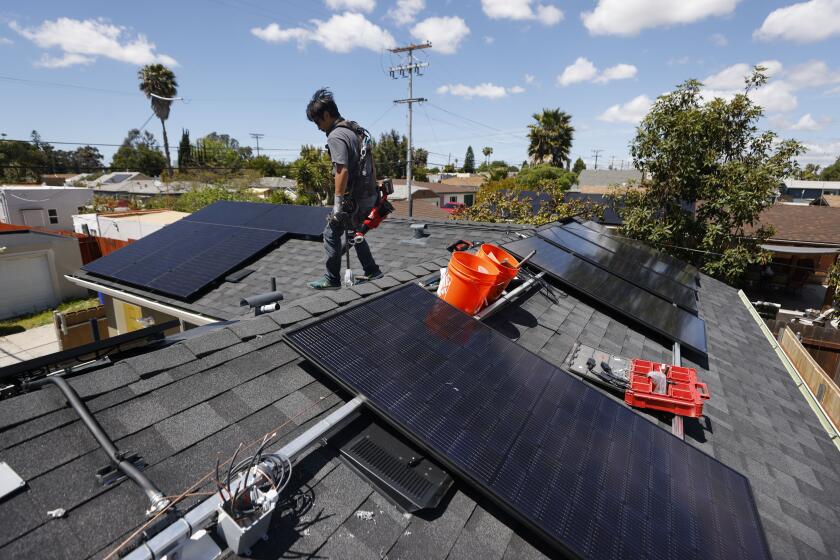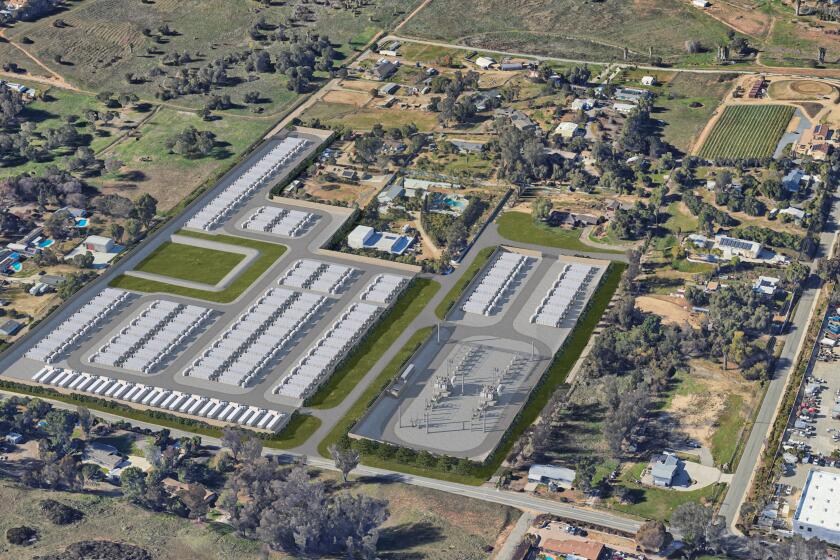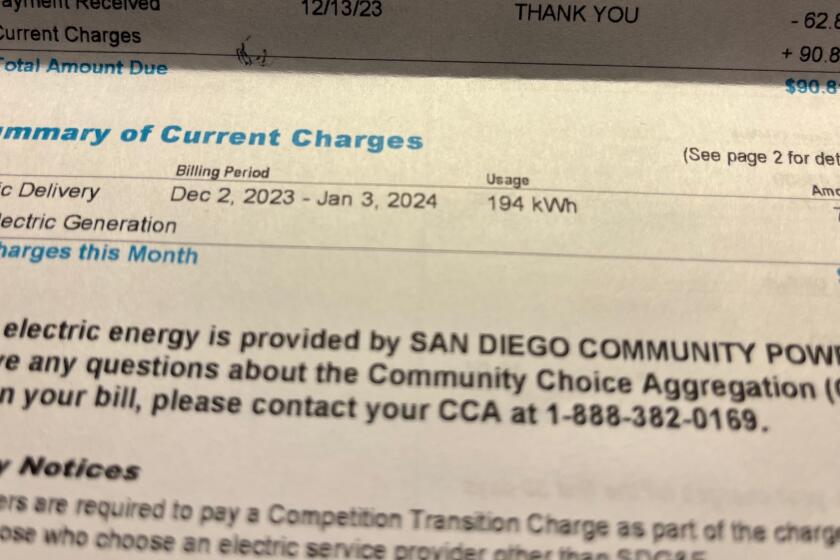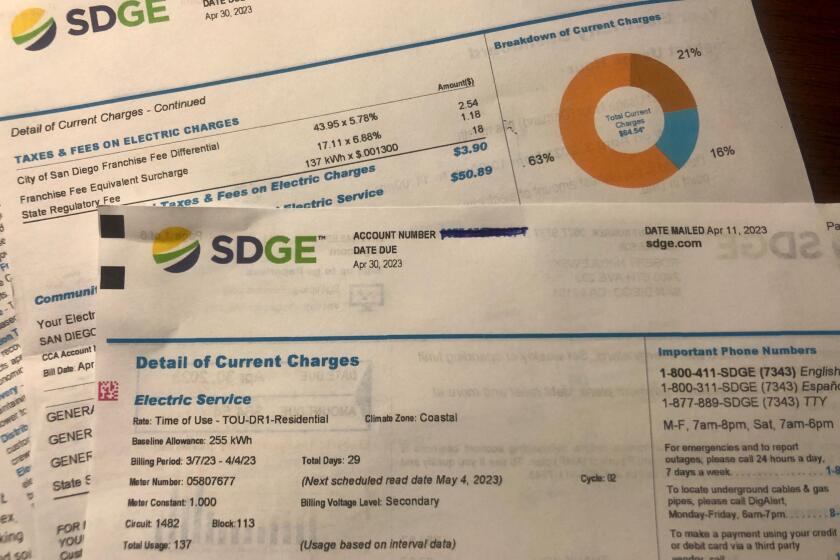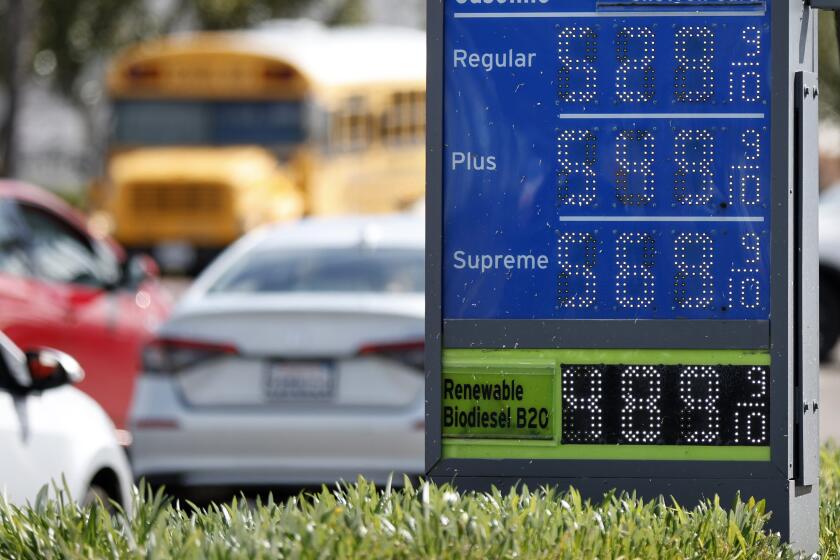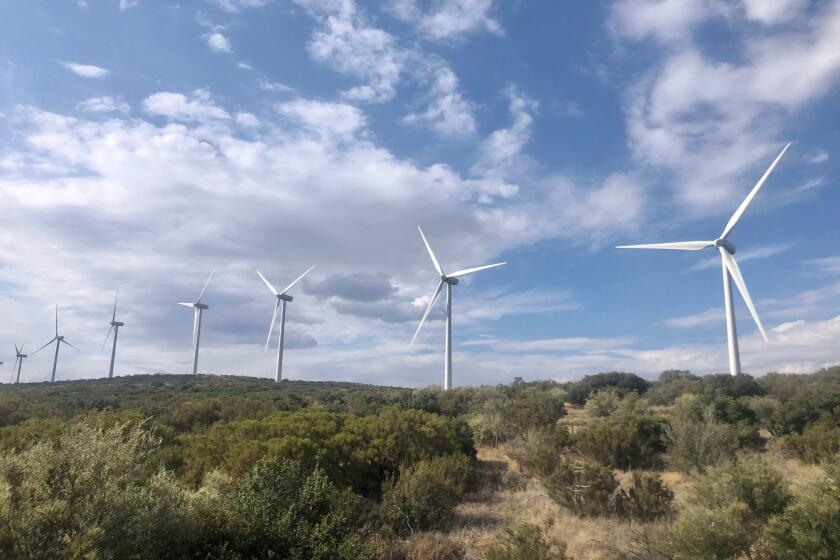Why SDG&E’s rates are higher than other California utilities
For more than a few San Diego Gas & Electric customers, a summer of discontent has just wrapped up.
Record heat in the San Diego area resulted in some residents seeing their monthly bills balloon and their complaints were compounded by a “high usage charge” the California Public Utilities Commission recently put in place.
But that’s not the only issue.
A year-over-year review by the Union-Tribune of electricity rate charges by the three investor-owned utilities shows SDG&E’s rates are not only higher than their cohorts but they have also been rising faster. Residential baseline rates during the summer months from June 1 through Oct. 1 have gone up 80.7 percent since January 2014.
And contrary to goals set by policymakers and regulators to bend upper-tier rates downward, SDG&E’s upper-tier has actually increased since 2014. By contrast, the upper-tier rates of the two other investor-owned utilities in California — Southern California Edison and Pacific Gas & Electric — have gone down.
SDG&E officials don’t dispute the numbers.
“We certainly acknowledge that our rates have become higher,” said Scott Crider, SDG&E’s vice president of customer services. “We’re listening to customer concerns and we’re taking them very seriously.”
As for the upward trend, SDG&E cites a number of reasons that include the complicated and often byzantine factors that go into the rate-setting proceedings at the CPUC.
And some energy experts say the commission, in its zeal to transform the state’s power mix while still maintaining a reliable grid, shoulders a large degree of responsibility since the CPUC has directed not only SDG&E but other power companies to develop energy and infrastructure projects. The costs associated with those projects show up in consumer rates.
In addition, there are larger explanations that go beyond SDG&E and extend to all utilities — such as the growth of rooftop solar and other energy options, which have eaten into the customer base of traditional power companies.
Looking at the numbers
The consumer advocacy arm of the CPUC recently took SDG&E to task for its rate increases.
The Public Advocates Office — formerly known as the Office of Ratepayer Advocates — filed a protest letter with the CPUC late last year, calling on the commission to direct SDG&E to explain its rate increases. The letter also said SDG&E “has had too many rate change filings during a short time frame which makes it difficult to observe the actual and cumulative rate impacts.”
Every three years, utilities in California go through a general rate case proceeding before the CPUC, where they make their cases for setting the price of rates.
In its last general rate case, SDG&E asked for a $133 million increase between 2016 and 2018. But the CPUC not only turned the utility down, it mandated a $3 million decrease.
So how could SDG&E raise its rates during that period? And how could its rates be higher than the two other investor-owned utilities?
As utility analysts point out, rate cases are not the final word when it comes to adjustments on customers’ bills.
For example, with an eye on reducing greenhouse gas emissions, state policymakers have ordered the investor-owned utilities to make investments in projects such as energy storage, electric vehicle charging stations and other infrastructure.
Those projects cost money and when they get approved by the CPUC, the utilities pass the costs of those projects onto ratepayers.
Among the reasons SDG&E officials cited for rate increases:
- More than 60 percent of SDG&E power lines are underground. Placing lines underground costs more than overhead lines but it does help reduce the chances of falling power lines igniting wildfires.
- In the aftermath of 2007’s deadly wildfires that destroyed more than 1,300 homes in the San Diego area, SDG&E has spent well over $1 billion on wildfire safety measures. The programs include establishing a state-of-the-art weather monitoring system and extending the months the utility activates the country’s largest water-dropping helitanker that holds up to 2,650 or water or fire suppressant to douse fires within moments of ignition.
- SDG&E has a smaller customer base than the other two utilities to spread those costs over. Edison, for example, has 15 million people in its service territory, compared to 3.6 million for SDG&E. “We have far fewer customers to spread those costs across,” Crider said.
SDG&E’s region includes more residential and small-business customers and fewer large, industrial customers than Edison and PG&E. Also, Crider said, the average SDG&E residential customer uses about 400 kilowatt-hours a month, compared to 600 kilowatt-hours a month for Edison.
“This results in investments having a little bit more of an impact on our customers,” Crider said.
“Greening” the grid is another factor.
State policymakers have directed utilities to find more renewable energy sources. Earlier this month, California enacted SB 100 that requires 60 percent of the state’s electricity come from renewable sources by 2030 and sets a goal to derive 100 percent from clean-energy by 2045.
SDG&E has been more aggressive than Edison and PG&E in this area, getting about 45 percent of its power from renewables, outpacing Edison (32 percent) and PG&E (33 percent).
“It would make sense that since we are adding a lot more (renewables) to our grid that our rates are going to be a little bit higher than theirs,” Crider said.
The CPUC must approve all revenue requests from utilities and the commission has approved a long list of projects requested by SDG&E (as well as Edison and PG&E).
Critics of the CPUC say too many times commissioners approve multi-million dollar projects and justify them on the grounds they translate into modest additions to a ratepayer’s bill.
“Even if you have one project that only adds a few pennies to each kilowatt-hour, if you approve 10 or 20 of them, it’s obvious the impact is going to be, in aggregate, greater,” said energy expert Gary Ackerman, former executive director of the Western Power Trading Forum, an organization based in Sacramento whose 90 members in the West buy and sell power. “It’s basically becoming a clean energy tax. It satisfies the whims of the politicians because they aren’t the ones paying for it.”
But in its protest letter, the Public Advocates Office, or CalPA, focused its attention on SDG&E, saying its rates “are increasing at an alarming rate” and criticizing where the utility’s tiered pricing is going.
Getting a fuller picture of the debate requires a quick history lesson.
Background
Traditionally, utility customers in California have been charged on a tiered system.
The lower tiers are less expensive than the upper tiers. As customers’ energy usage increases into higher tiers, the price they pay increases as well.
In the aftermath of California’s energy crisis of 2000 and 2001 that saw rolling blackouts across the state, the Legislature directed the CPUC to freeze low-tier residential rates on customers.
But that led to a problem. As utility costs rose in subsequent years, that meant the rates in higher tiers kept going up since the lower tier rates were frozen in place.
In the 2013 legislative session, Sacramento passed an expansive bill, AB 327, that reformed rates.
Why? Because the CPUC — and many of the parties that follow and weigh in on commission activities — believed that steeply tiered rates led to more volatile bills for residential customers.
Among other things, AB 327 led the CPUC to eliminate the low-tier rate freeze.
And since the differential between the lower tier and the upper tiers was getting extreme, policymakers decided to reduce the total number of tiers from five to two.
The new plan called for pushing up rates in the lower tier while pushing down rates in the upper tier. The goal was to flatten the differential between Tiers 1 and 2 to 25 percent.
On top of all that, the CPUC ordered the utilities to institute a “high usage charge” that is even more expensive than Tier 2.
It went into effect last November to send a price signal to customers who go over the 400 percent mark that they should reduce their energy use.
How a two-tiered system works
Every residence is assigned a “baseline allowance” in kilowatt-hours to meet what is considered the “reasonable” energy needs of an average ratepayer in a given climate zone — coastal, inland, mountain or desert.
The baseline allowance is typically found on Page 2 of the SDG&E monthly statement.
Tier 1 rates apply for each kilowatt-hour consumed up to the 100 percent of the baseline allowance.
Once that threshold is passed, the more expensive Tier 2 prices go into effect. (However, in the case of SDG&E, customers today are allowed to go up to 130 percent of baseline before Tier 2 rates start to kick in.)
But it doesn’t stop there.
If a residential customer exceed four times (400 percent) the baseline allowance, the high-usage charge goes into effect.
What happened
As the number of tiers has collapsed, the prices in Tier 1 among all three investor-owned utilities have been going up. That’s by design.
Conversely, the goal is for Tier 2 prices are supposed to come down, in order to move them within 25 percentage points of each other.
But that’s not what has happened with SDG&E rates. Instead rates have going up in both Tier 1 and Tier 2.
In 2014, SDG&E Tier 1 residential customers using up to 100 percent of their baseline paid 15 cents per kilowatt-hour during the summer months (June 1-Oct. 31), according to CalPA. Today, they pay 27.1 cents per kilowatt-hour, an increase of 80.7 percent.
During the winter months (Nov. 1 through May 31), the increase was 53.3 percent.
How do those numbers compare to SDG&E’s cohorts, Southern California Edison and PG&E?
According to CalPA, Edison residential customers in 2014 using up to 100 percent of baseline paid 13.2 cents per kilowatt-hour at Tier 1. Now they pay 17 cents per kilowatt-hour, an increase of 28.8 percent.
PG&E residential customers in 2014 using up to 100 percent of baseline paid 13.2 cents per kilowatt-hour, as per CalPA figures. Now they pay 21.5 cents per kilowatt-hour for Tier 1, an increase of 62.9 percent — a big increase but not as steep as the 80.7 percent seen for SDG&E’s summer months.
(Edison and PG&E do not divide their rates between summer and winter months.)
What about the upper tier rates?
SDG&E residential customers in the summer months of 2014 who exceeded 130 percent of their baseline allotment in 2014 paid 35.8 cents a kilowatt-hour during summertime rates. This year, they paid 47.5 cents per kilowatt-hour — an increase of 32.7 percent.
SDG&E’s upper tier winter rates also increased during the 2014-2018 time frame, going from 33.9 cents per kilowatt-hour to 40.4 cents per kilowatt-hour. That’s an increase of 19.2 percent.
But the Tier 2 rates were supposed to come down.
They did for Southern California Edison and PG&E.
Edison customers in 2014 who used between 131 and 200 percent of baseline paid 27.4 cents a kilowatt-hour and once they went 201 percent or higher they paid 30.4 cents per kilowatt-hour. By 2018, they paid 25 cents a kilowatt-hour in both instances, a reduction of 8.8 percent and 17.8 percent, respectively.
PG&E customers in 2014 who exceeded between 130 and 200 percent paid 32.4 cents a kilowatt-hour and once they went 201 percent or higher they paid 36.4 cents per kilowatt-hour. By 2018, they paid 28.5 cents a kilowatt-hour in both instances, a reduction of 12.0 percent and 21.7 percent, respectively.
In addition, that newly instituted high usage charge for exceeding 400 percent of baseline is 55 cents a kilowatt-hour for SDG&E for summer and 47 cents for winter.
By comparison, the high usage charge for Edison is 35 cents per kilowatt-hour and 44.1 cents for PG&E.
“It’s an ugly story for the SDG&E service territory,” said Michael Campbell, program manager at the Public Advocates Office, the consumer advocacy group within the California Public Utilities Commission. “There’s no relief across the spectrum. Nobody’s getting rate reduction, regardless of usage.”
Crider of SDG&E said, “We would like to get to the 25 percent differential tomorrow … It’s something that we’ve been working toward.”
Why did SDG&E’s tiered rates go up? As the utility explains it, the tier differentials for Edison and PG&E were closer together than SDG&E’s at the start of the process, making the job tougher for SDG&E to reach the 25 percent differential.
In addition, SDG&E said the CPUC has placed caps on how much Tier 1 can increase, meaning collections had to collected from rates in Tier 2 thus slowing, the utility said, its ability to collapse tiers.
“Today we have a 75 percent differential between tiers,” said SDG&E spokesman Wes Jones in an email. “When we started in 2015, it was more than 100 percent. We have made progress, although not as much as we had hoped for at this point.”
In its protest letter to the CPUC last November, CalPA was less forgiving.
It called on the CPUC to turn down SDG&E’s proposed residential rates and offered an alternative that would have smoothed out the rates’ impacts over time.
But in July, the CPUC denied the protest, saying SDG&E had “satisfactorily addressed” the complaints of CalPA and others. Plus, the rates had already been authorized and approved by the commission.
“There’s a very real concern that we’re at a place where customers, regardless of their level of usage, are seeing significant increases in their bills and are justifiably upset about that,” Campbell said.
Crider said SDG&E officials think they have “a pathway” to reach the 25 percent price differential between Tiers 1 and 2 within the next two years. “That’s what we’re continuing to strive for.”
But SDG&E got an earful from customers this summer who saw their bills soar as high as the temperatures.
By the utility’s own estimation, almost 81,000 customers this year have gone 400 percent over baseline in a given month, thus triggering the super-expensive high usage charge.
Earlier Wednesday, SDG&E officials announced they plan to lobby the CPUC to adopt some changes aimed at giving customers a break on their bills. Among them? Eliminating the high usage charge altogether and getting rid of seasonal pricing (summer/winter) and having just one, consistent year-round price.
“One thing that we’ve heard loud and clear from our customers this summer is that they do not like the high usage charge and we agree,” Crider said.
Some SDG&E critics wondered aloud if the proposals were more cosmetic than substantive.
“The best way to avoid rate shock is to reduce rates. But SDG&E isn’t saying, ‘We’re reducing rates,’ “ said Mindy Spatt, communications director at consumer advocacy group The Utility Reform Network. “If high usage customers aren’t going to pay (the high usage charge), won’t other customers have to make up the difference?”
A shrinking base
Longtime observers point to another factor — sales volume for utilities has been going down.
More households have installed photovoltaic solar panels on their rooftops. That not only reduces their electricity bills but through the state’s net energy metering system, those customers can sell their excess power back to the grid at the retail, rather than the wholesale, price of power.
Other consumers get power from a growing number of alternative sources — such as from local agencies called Community Choice Aggregators, or CCAs, that wrest control of power purchases from utilities or from private electric re-sellers called and direct access providers.
What’s more, California has been a national leader in establishing energy efficiency standards and mandates that reduce the amount of energy expended from light bulbs, appliances, computers and other items that suck up power. Earlier this year, the state instituted a new rule requiring all new homes come equipped with solar systems.
All of that leads to an eroding customer base for the traditional utility model.
”We have a hundred years of history of the electricity industry in California and the United States,” said CPUC President Michael Picker at a meeting this week. “A lot of change has come about in the last 10 years. There are many options people are exploring that don’t have that long history so they’re harder to predict. All I can tell you is that the only thing that’s common to change is more change.”
Business
rob.nikolewski@sduniontribune.com
(619) 293-1251 Twitter: @robnikolewski
Get U-T Business in your inbox on Mondays
Get ready for your week with the week’s top business stories from San Diego and California, in your inbox Monday mornings.
You may occasionally receive promotional content from the San Diego Union-Tribune.


